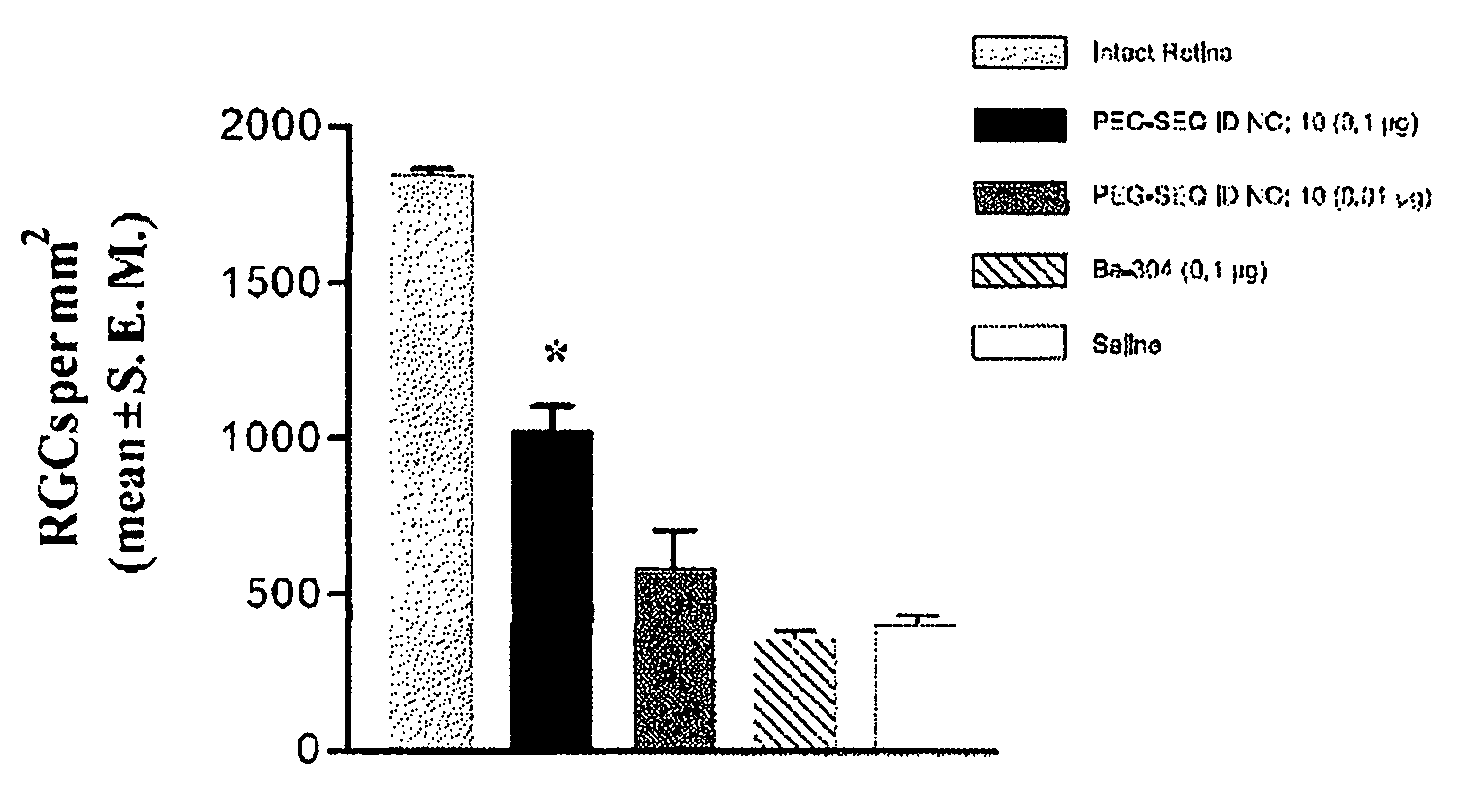ADP-ribosyl transferase fusion variant proteins
a technology of ribosyl transferase and variant proteins, which is applied in the direction of peptide/protein ingredients, immunological disorders, metabolism disorders, etc., can solve the problems of permanent functional impairment, loss of axons that are damaged, deficits associated with spinal cord injury, etc., and achieve the effect of preventing or inhibiting uncontrolled proliferation
- Summary
- Abstract
- Description
- Claims
- Application Information
AI Technical Summary
Benefits of technology
Problems solved by technology
Method used
Image
Examples
example 1
[0246]Data from a typical Matrigel assay experiment, for example relating to the effect of a pharmaceutical composition comprising a fusion protein designated as SEQ ID NO: 8 on length of an angiogenesis-derived capillary network are summarized in Table 7. These data show that the network formation was inhibited by approximately 13% to about 20% under the dose and formulation conditions used versus the inhibition produced by a control vehicle wherein zero inhibition provides 100% growth. This effect on angiogenesis can be enhanced by using higher doses of fusion protein and by preincubation of the HUVEC cells with SEQ ID NO: 8 prior to addition of the cells to Matrigel. The anti-angiogenesis effect of a composition comprising a polypeptide of this invention comprising an amino acid sequence of a transport agent covalently linked to an amino acid sequence of an active agent, wherein the amino acid sequence of the active agent retains an ADP-ribosyl transferas...
example 2
Preparation of SEQ ID NO: 43 and SEQ ID NO: 10
[0248]SEQ ID NO: 43 is prepared by polymerase chain reaction and subcloned into pET9a vector to create SEQ ID NO: 10. Two oligonucleotides are designed to delete amino acids 3-17 by site-directed-mutagenesis using the QuikChange (Stratagene) kit. Polymerase chain reaction is carried out in a thermo cycler using 50 ng of the pET9a-C3-variant, using 42-mer mutant primers: primer 2029F 5′-GGA GAT ATA CAT ATG TC*G GCT TAT TCA AAT ACT TAC CAG GAG-3′ (SEQ ID NO: 11); and primer 2029R 5′-CTC CTG GTA AGT ATT TGA ATA AGC C*GA CAT ATG TAT ATC TCC-3′(SEQ ID NO: SEQ ID NO: 12). The symbol (*) indicates the junction where the 45 nucleotide deletion occurred.
[0249]DpnI digestion is done according to the manufacturer's instructions and 1 μL of this product was used to transform XL1-Blue Super-competent cells (InVitrogen). These plates are then incubated overnight at 37° C. Clones of putative SEQ ID NO: 10 are selected and their plasmid DNA amplified an...
example 3
Preparation of SEQ ID NO: 10 Fusion Protein
[0251]SEQ ID NO: 10 is derived from the cell-penetrating C3 exoenzyme variant, SEQ ID NO: 44. SEQ ID NO: 44 is transferred from the pGEX-4T vector to the pET9a vector to improve expression and eliminate the GST fusion tag. The resulting variant, SEQ ID NO: 43, is purified by FPLC using an Akta Explorer™ (Amersham Biosciences, Montreal, QC). In order to achieve a robust process for cGMP manufacturing, site-directed mutagenesis is employed to remove vestigial residues at the N-terminus and eliminate protease sensitive residues to obtain SEQ ID NO: 10.
[0252]SEQ ID NOs: 44 or 10 are purified using standard techniques known in the art. For example, SEQ ID NOs: 44 or 10 are expressed in E. coli BL21 (DE3) cells grown in 4 L flasks. Following induction with IPTG, cells are extracted by sonication and precipitated with polyethyleneimine and ammonium sulfate or filtered to remove the bulk of the nucleic acids. The lysates are passed through an SPXL ...
PUM
 Login to View More
Login to View More Abstract
Description
Claims
Application Information
 Login to View More
Login to View More - R&D
- Intellectual Property
- Life Sciences
- Materials
- Tech Scout
- Unparalleled Data Quality
- Higher Quality Content
- 60% Fewer Hallucinations
Browse by: Latest US Patents, China's latest patents, Technical Efficacy Thesaurus, Application Domain, Technology Topic, Popular Technical Reports.
© 2025 PatSnap. All rights reserved.Legal|Privacy policy|Modern Slavery Act Transparency Statement|Sitemap|About US| Contact US: help@patsnap.com



